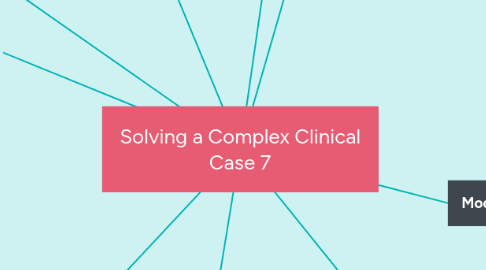
1. Coast goals:
1.1. LTG: Client will independently engaging in feeding when presented with food in 3 out of 5 opportunities by 6 months.
1.2. STG: Client will engage in feeding when presented with foods in 1 out of 5 opportunities with maximum verbal cues by 1 month.
2. Results
2.1. Outcomes
2.1.1. Quality of life
2.1.2. Occupational Performance
2.1.3. Well being
2.1.4. Health and Wellness
2.1.5. Participation
2.2. Intervention Types
2.2.1. Education & Training
2.2.2. Occupation and Activities
3. Problem 1: Gags when presented with food
3.1. Intervention Approach
3.1.1. Establish, restore
3.2. Intervention Strategy
3.2.1. Child will work on tongue lateralization, desensitization (i.e. being introduced to food with different textures such as pureed foods, thickening agents: nectar, honey to reduce risks of aspiration and/or GERD), and oral stimulation, and gum massage, by using a toothbrush or oro-Navigator. Child can do this to themselves or education can be provided to the mother on how to perform this technique.
3.3. Evidence Based
3.3.1. Brudney J. (2017) Learning to Eat After Esophageal Atresia Repair: In Infancy and Childhood. In: Till H., Thomson M., Foker J., Holcomb III G., Khan K. (eds) Esophageal and Gastric Disorders in Infancy and Childhood. Springer, Berlin, Heidelberg
4. Problem 2: Refuses to attempt to eat
4.1. Coast goals:
4.1.1. LTG: Client will try new foods in ⅔ opportunities with a min-mod. verbal cues in 6 months.
4.1.2. STG: Client will try new foods in ⅓ opportunities with maximum verbal cueing in 1 month.
4.2. Intervention Approach
4.2.1. Establish, restore
4.3. Intervention Strategy
4.3.1. Education will be provided to the mother on postural changes and behavior changes to implement into daily routine.
4.4. Evidence Based
4.4.1. Slater, B. J., Rothenberg, S. S. (2017). Gastroesophageal Reflux. Seminars in Pediatric Surgery. 26(2) pp. 56-60. Retrieved from:Redirecting
5. Problem 3: Fine Motor Skills & Social Participation
5.1. Coast goals:
5.1.1. LTG: Client will engage in age appropriate fine motor skills (i.e., handwriting name, stacking blocks, coloring) in 6 months.
5.1.2. STG: Client will demonstrate fine motor skills of handwriting name with hand over hand assistance in 1 month.
5.2. Intervention Approach
5.2.1. Establish, restore
5.3. Intervention Strategy
5.3.1. Group play therapy with other children of similar skill and ability to promote appropriate social participation and acquisition of fine motor skills.
5.4. Evidence Based
5.4.1. Hekal, Ola Abd El-Rahman Ali and Darwish, Mirret Mohamed and Moghny Attia, Azza Abdel and Osman, Zeinab Abd El-Halim and Ehsan, Iman Ahmed, Effect of Selected Play Activities on Adaptive Skills Among Children with Down Syndrome (November 2017). IMPACT: International Journal of Research in Applied, Natural and Social Sciences (IMPACT: IJRANSS) ISSN (P): 2347-4580; ISSN (E): 2321-8851 Vol. 5, Issue 11, Nov 2017, 77-86. Retrieved from: https://ssrn.com/abstract=3090977
6. One Treatment that might not be appropriate
6.1. One intervention we wouldn’t try is introducing a swallowing technique for solid foods without receiving instructions from a SP.
7. Model/FOR
7.1. Lifespan Frame of Referance
7.2. MOHO
7.3. Rehabilitative FOR
8. Client is a 4 year old boy with a esophageal atresia. Client lives with mother who is native to Costa Rica and speaks little English. Client underwent multiple surgeries. Him and his mother have little social interaction. Child has undergone a 3rd surgery to correct the issue. Client is seeking OT services for feeding, and developmental delays.
8.1. Diagnosis
8.1.1. Esophageal Atresia
8.2. Prevalence
8.2.1. Esophageal atresia (EA) is a rare congenital disorder, in which infants lack a fully developed and functional esophagus. It occurs in 1 of 4,300 pregnancies in the US (CDC). There are four types of esophageal atresia: Type A, Type B, Type C and Type D. Type A is when the upper and lower parts of the esophagus do not connect and have closed ends. In this type, no parts of the esophagus attach to the trachea. Type B is very rare. In this type the upper part of the esophagus is attached to the trachea, but the lower part of the esophagus has a closed end. Type C is the most common type. In this type the upper part of the esophagus has a closed end and the lower part of the esophagus is attached to the trachea, as is shown in the drawing. Type D is the rarest and most severe. In this type the upper and lower parts of the esophagus are not connected to each other, but each is connected separately to the trachea. The cause of EA remain unknown however the Center for Disease Control (CDC) has reported possible factors to include: genetic abnormality, parental age, and/or the use of assistive reproductive technology. There comorbidities associated with EA include (i.e., tracheoesophageal fistula (TEF), trisomy 13/18/21, heart defects, gastrointestinal defects, kidney and urinary tract defects, tethered spinal cord, and musculoskeletal defects (Boston’s Children Hospital). It is common to see infants with EA to have TEF as well. TEF is another birth defect in which a part of the esophagus is connected to the trachea.
8.3. Symptoms
8.3.1. Common symptoms are difficulty breathing and/or choking/coughing when swallowing foods (CDC). Common signs are infants constantly drooling, experiencing difficulty when swallowing saliva and/or food.
8.4. Prognosis of the diagnosis/disability
8.4.1. "Once a diagnosis has been made, surgery is needed to reconnect the two ends of the esophagus so that the baby can breathe and feed properly. Multiple surgeries and other procedures or medications may be needed, particularly if the baby’s repaired esophagus becomes too narrow for food to pass through it; if the muscles of the esophagus don’t work well enough to move food into the stomach; or if digested food in the stomach consistently moves back up into the esophagus." (CDC.gov)
8.5. References
8.5.1. Center for Disease Control. (2019). Esophageal Atresia. Retrieved from Facts about Esophageal Atresia | CDC
